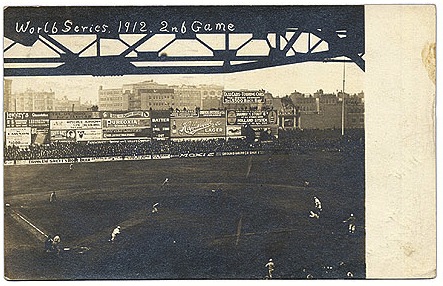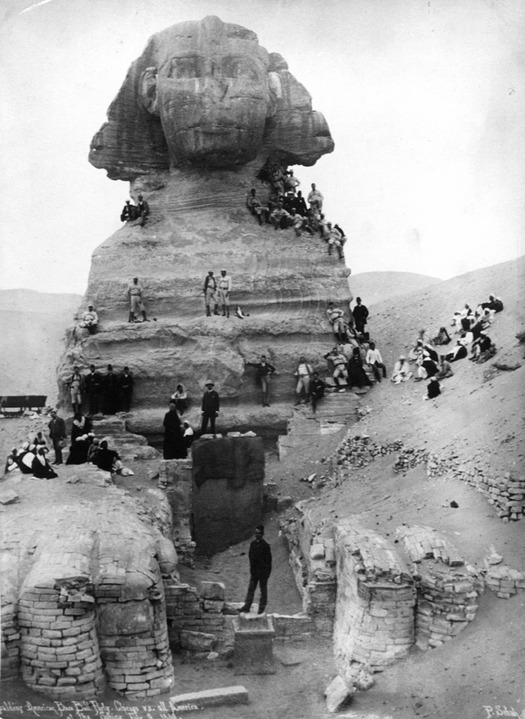
April 20, 2012
A Century at the Ballpark

Fenway during the 1912 World Series. Note the fans in front of the ad-shrouded left-field wall, not yet the Green Monster. Boston lost this game, but won the series.
Fenway Park marks its centennial this afternoon. There will be a ceremony, and then a good-old-fashioned day game against the Yankees, their opponents when the place opened a century ago, with both teams in vintage uniforms. The Yankees weren’t the Yankees back then—they were the Highlanders, or the New Yorks—and Boston was the class of baseball, the future World Series champs. Team ace “Smokey” Joe Wood went 34-5 that year, with 258 strikeouts. The outfield was one of legend: Tris Speaker, Duffy Lewis, and Harry Hooper, a college-educated engineer who had signed with the Sox for 1909 on the promise that he’d get to work on the design of the team’s new ballpark. Hooper didn’t get to work on Fenway, but he played there for nine years, and made it to the Hall of Fame, a reasonable consolation.
As that anecdote suggests, Fenway was not designed by an architectural firm, but by the Osborne Engineering Company, a specialist in sports facilities that would be responsible for, among many others, the stadium the Yankees would soon construct in the Bronx. (Built, of course, for Babe Ruth, the star they purloined from the Sox.) Today, it is the architectural firm Populous that has a virtual monopoly on the design of ballparks, and for the last couple of decades idiosyncratic Fenway has been a model for their designs.

“Smokey” Joe, crowded by fans, warming up before his signature pitching duel against Walter Johnson in Fenway’s inaugural year. Boston won, 1-0.
This year, in fact, marks the twentieth anniversary of the Populous ballpark that launched the retro-stadium trend: Oriole Park at Camden Yards. It also marks the debut of another Populous product, Miami Marlins Park, a striking white structure inspired by the work of Richard Meier. (Its most dramatic feature is a trippy Red Grooms sculpture that activates when the Marlins hit a home run). Have we seen the end of nostalgic ballpark design? I doubt it. But owners who believe design, of any kind, will promote attendance or fan appreciation are fooling themselves: fans care only about winning. History tells us they will show up to see a good product on the field no matter what the surroundings, and they’ll stay home if the play stinks, even if it’s in a palace. An important lesson.
Fenway is a reminder of this lesson. (So is Dodger Stadium, celebrating its 50th anniversary this year.) For all the extraordinary work that has gone into renovating and adding amenities to Fenway, it remains a cramped place where you sit with your neighbor’s elbows in your gut. The circulation is awful. But that’s its charm. You’re right on top of the action, and part of a crowd in a way you are not in the relative luxury of a modern park. There is no better place to watch a ballgame. I hope it lasts another century.

Spalding’s tourists on the Great Sphinx. After the photo session, they had a contest to see who could hit it in the eye with a ball.
Some personal baseball news: I am happy to announce that the research archive I assembled in the writing of my first book, Spalding’s World Tour, has been acquired by the Hall of Fame, and will shortly be accessible to writers, scholars, and all other interested parties as the Mark Lamster Papers (!) at the Hall’s library in Cooperstown. The book tells the story of two all-star baseball teams that travelled around the globe in 1888-89 as cultural diplomats on a mission to promote baseball and the American way. It wasn’t quite a bestseller, but I field inquiries about the tour with some regularity; its focus on the intersection of political, commercial, and cultural activity seems to me especially relevant today, and is likely to remain so. That this material has a permanent home is satisfying indeed. To state the obvious, it’s a great honor to have my work included in that extraordinary collection.
Observed
View all
Observed
By Mark Lamster
Related Posts

Equity Observer
L’Oreal Thompson Payton|Essays
‘Misogynoir is a distraction’: Moya Bailey on why Kamala Harris (or any U.S. president) is not going to save us

Equity Observer
Ellen McGirt|Essays
I’m looking for a dad in finance

She the People
Aimee Allison|Audio
She the People with Aimee Allison, a new podcast from Design Observer

Equity Observer
Kevin Bethune|Essays
Oh My, AI
Related Posts

Equity Observer
L’Oreal Thompson Payton|Essays
‘Misogynoir is a distraction’: Moya Bailey on why Kamala Harris (or any U.S. president) is not going to save us

Equity Observer
Ellen McGirt|Essays
I’m looking for a dad in finance

She the People
Aimee Allison|Audio
She the People with Aimee Allison, a new podcast from Design Observer

Equity Observer
Kevin Bethune|Essays
